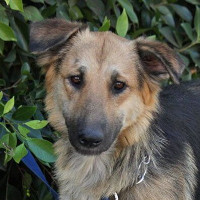 |
Sheltie Shepherd |
|
He is not recognized by the F.C.I. |
Origin |
Great Britain <> Germany -> U.S.A. | |
Translation |
Francis Vandersteen |
A brief presentation of the Sheltie Shepherd |
| The Sheltie Shepherd is a magnificent hybrid of the German Shepherd and the Shetland Sheepdog. Both are intelligent, friendly dogs who love to play as much as they love to work. This breed makes a wonderful family pet, and can also be useful as a herding dog if you need one. If not properly trained, they can try to herd your other pets or children. Fortunately, they are easy to train and learn quickly, provided you are firm and follow the rules. Their long double coat requires frequent maintenance and they also need a moderate amount of daily exercise, but they make a wonderful addition to the family and can live for over 15 years. |
History of the Sheltie Shepherd |
| As the Sheltie Shepherd is a designer dog, you need to consider the history of its parent breeds to get an idea of its origins. The Sheltie Shepherd takes after its hard-working, determined ancestors. |
A little of the Shetland Sheepdog |
||
| The Shetland Sheepdog takes its name from the Shetland Islands in Scotland, where it was first discovered. They were bred from the Border Collie, King Charles Terrier and Icelandic Sheepdog to guard sheep. The breed has also been used to herd cattle, horses and chickens, as well as being an affectionate and loyal pet. When the British navy returned to England from the Shetland Islands for training, they brought back some of these dogs, which immediately became popular. The American Kennel Club accepted the Shetland Sheepdog into its club in 1911. | ||
 |
||
| Standard of the Shetland Sheepdog |
A little of the German Shepherd |
| The German Shepherd originated in Germany and was developed by a man named Captain Max von Stephanitz in the 1800s to herd and protect large groups of sheep. The captain and other shepherds chose a variety of sheepdogs with certain characteristics such as a powerful sense of smell, strength, speed and intelligence. They were also popular as military dogs, delivering meals and other supplies to the troops during the First World War. In 1899, a dog named Horan was the first German Shepherd to be registered. He went through a few name changes due to discord with Germany, but soon reverted to the German Shepherd name. They came to be known for their bravery and intelligence, and were used by the police and army, for search and rescue and to help the disabled. The German Shepherd was recognized by the American Kennel Club in 1908 and is the second most common dog breed. |
 |
| Standard of the German Shepherd |
Appearance of the Sheltie Shepherd |
| The Sheltie Shepherd is a large dog, weighing between 25 and 30 kilos and measuring around 63.5 centimeters. Their double coat is medium to long, straight and thick. It comes in a multitude of colors, such as black, brown and white, tan, cream and black, russet, fawn, brown, black, pied, sable, pinto, merle, brindle or any combination of these. They generally have the long muzzle of the Shetland Sheepdog with a black or brown nose, brown eyes and intelligent expression. They have long, graceful bodies and legs, long furry tails and pointed, erect ears. |
Temperament of the Sheltie Shepherd |
| The Sheltie Shepherd is an excellent choice for a family pet, especially for those with a large fenced yard where your dog can play. This breed is a sociable and wonderfully intelligent dog that loves to play with other animals and children, but needs to be supervised with the little ones. It's best to socialize your Sheltie Shepherd early on and train him properly. You need to be consistent and patient because, although they learn quickly, some can be a little stubborn. They are natural shepherds and may try to herd small pets and children, but with good training you can avoid this problem. |
Needs and activities of the Sheltie Shepherd |
| Your Sheltie Shepherd needs around 45 minutes to an hour of brisk exercise a day to stay healthy and happy. Dogs that don't get enough mental and physical activity every day can become bored or anxious. This can lead to aggression, excessive barking and other behavioral problems. Activities to enjoy with your companion include playing with other dogs at the dog park, going for walks, hiking, playing Frisbee or flyball, swimming and taking part in agility trials. As your Sheltie Shepherd is a natural herder, this breed would love to be able to herd all kinds of animals on a daily basis. However, if you don't have livestock to herd, you can take your dog to a herding trial to compete against other dogs. |
Maintenance of the Sheltie Shepherd |
| This breed's dense, double coat requires a lot of maintenance. You'll need to brush your Sheltie Shepherd carefully with a stainless steel comb and a spiked brush several times a week. You should also use a hair removal tool or stiff bristle brush daily to minimize shedding, as they tend to shed a lot. Only bathe your dog once a month, or as needed, with a mild shampoo. Frequent shampooing can cause skin dryness and irritation. When you bathe your Sheltie Shepherd, you should also clean his ears and check for earwax build-up and other debris. Dental disease can be prevented by daily teeth cleaning. |






 English (United Kingdom)
English (United Kingdom)